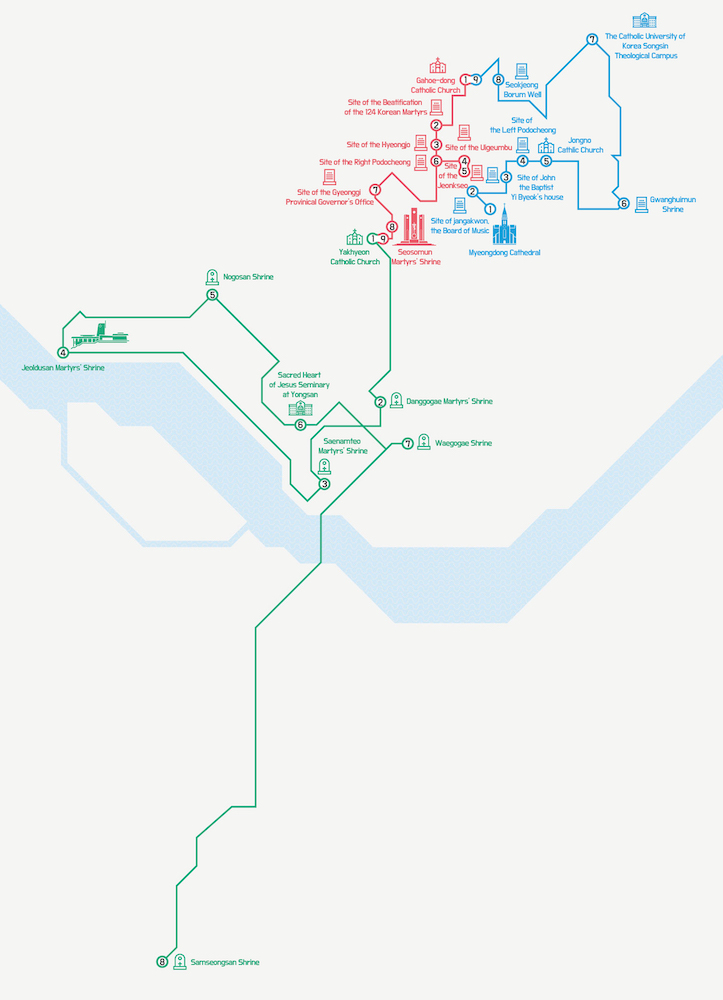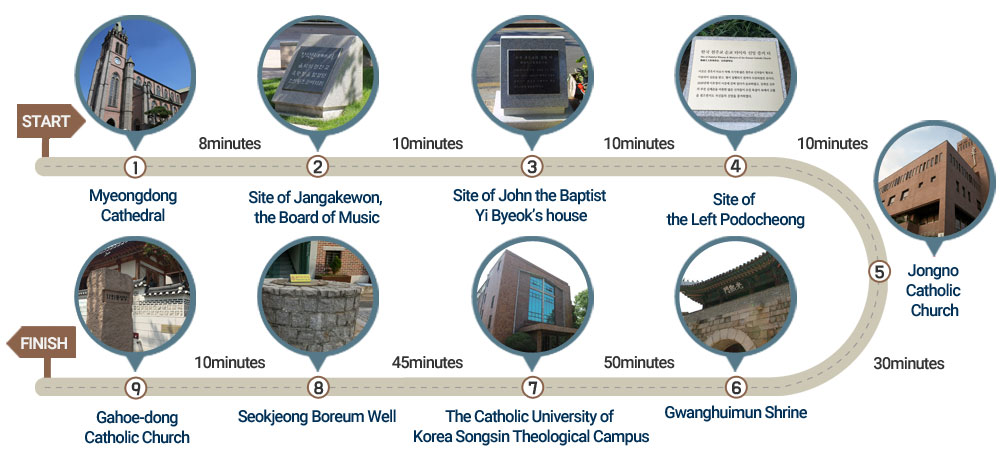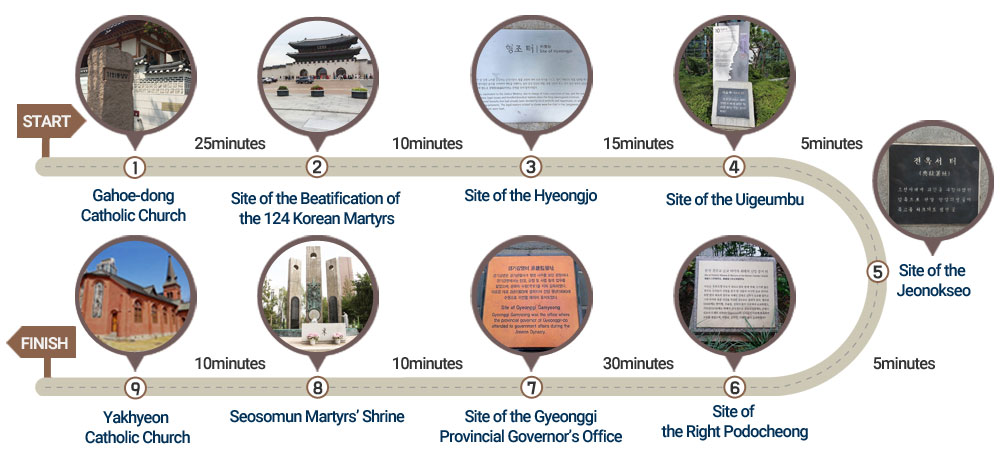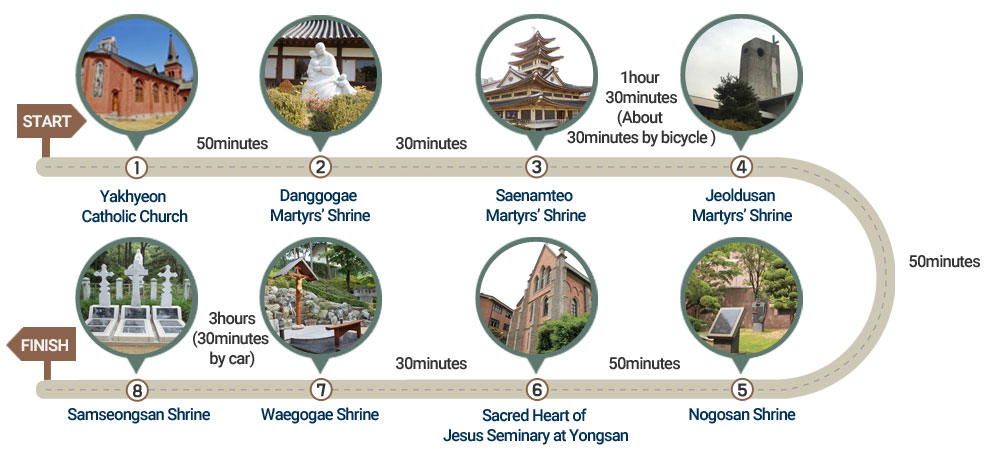Last Updated on 2 years by admin
Seoul Pilgrimage Route is the Asia’s first official international pilgrimage by the Vatican where you can explore the religious history in Korea.
Seoul is a metropolis that has become extremely well-known in recent decades for its influence on pop culture. This is understandable given that it is the birthplace of K-Pop, Korean dramas, and delectable delicacies such as tteok-bokki and bibimbap.
On the other hand, Seoul is a city steeped in history, with many important cultural and classical sites. Notable among these are the city’s Catholic churches.
On September 14th, 2018, the Vatican designated ‘The Seoul Catholic Pilgrimage Route,’ which is beloved by the church and civic society, as the first Asian International Pilgrimage Site. It became a reality as a result of several pilgrims’ visits and worries.

There are a total of 3 pilgrimage routes around Seoul, and these routes are connected. So technically, you could cover all the three routes one after the other as if they are all just one long route.
Since 2015, the Seoul Archdiocese’s Martyrs Exaltation Committee has made various efforts to renew the management articles of each pilgrim site. They also focus on strengthening the related cultural sources’ facilities, creating content, authenticating the historical shreds of evidence of Korean Catholic Church’s relics, and holding related academic and cultural events to gain recognition of Seoul Catholic Pilgrimage Site International Pilgrimage Site by the Vatican.
Seoul Catholic Pilgrimage Route 1 Course – The Good News Road
What was the origin of the Catholic Church in Korea?
Those who travel the Good News Road can begin to find an answer to this enthralling topic.
This pilgrimage, known as the Good News Road, reminds all who travel it of the significance of the community of laypeople who voluntarily received the Word of the Gospel, an act unprecedented in Church history.

This route begins with a visit to the residences of Thomas Kim Beom-u (Korea’s first evangelist) and John the Baptist Yi Byeok (the site of the first baptisms in Korea.) The trek continues to Seokjeong Boreum Well, whose waters Fr. James Zhou Wen-mo, Korea’s first priest and missionary, blessed for the celebration of the sacrament of baptism.
The pilgrim is encouraged to visit Gahoe-dong Catholic Church in Gye-dong. The church was built in the region where Fr. Zhou worked, and it gives a peaceful place to reflect on Fr. Zhou’s life and martyrdom, as well as the early believers to whom he ministered.
This route is 8.7 km (5.4 miles) long, and takes around 3 hours and 45 minutes to complete.
On this route, you will get to visit the Myeongdong Cathedral, Site of Jangakewon – the Board of Music, Site of John the Baptist Yi Byeok’s House, Site of The Left Podocheong, Jongno Catholic Church, Gwanghuimun Shrine, The Catholic University of Korea Songsin Theological Campus, Seokjeong Boreum Well and the Gahoe-dong Catholic Church.
Seoul Catholic Pilgrimage Route 2 Course – The Eternal Life Road
Catholicism was seen as a bad practice under the Joseon Dynasty for placing the word of God over the orders of the ruler, and a series of Catholic persecutions occurred. The Eternal Life Road, which preserves the remnants of these persecutions’ past, includes the historically significant Seosomun Martyrs’ Site, where the greatest numbers of Catholic believers were beheaded. The Site of Hyeongjo, the Site of the Right Podocheong, and the Site of the Gyeonggi Provincial Governor’s Office may also be found along the road.
Martyrdom is the greatest test of one’s faith, and many Catholic Christians gave their lives in pursuit of the noble truth, unwavering in their hope and belief in the ‘everlasting life’ given by Jesus Christ. Although the forebears of faith died as martyrs, they were also on a journey to gain everlasting life, which is why this path has been dubbed the Eternal Life Road.

The sites are no longer in their original state, but they will inspire pilgrims to think on both the persecution of Catholicism that took place on this exact soil, as well as the universal values pursued by the martyrs.
Pilgrims are naturally challenged to consider what is most important in their life as they follow in the footsteps of those who put their faith before their own lives.
This route is 5.9 km (3.6 miles) long, and takes around 2 hours and 30 minutes to complete.
On this route, you will get to visit the Gahoe-dong Catholic Church, Site of the Beatification of the 124 Korean Martyrs, Site of the Hyeongjo, Site of the Uigeumbu, Site of the Jeonokseo, Site of the Right Podocheong, Site of the Gyeonggi Provincial Governor’s Office, Seosomun Martyrs’ Shrine, and the Yakhyeon Catholic Church.
Seoul Catholic Pilgrimage Route 3 Course – The Unity Road
The Unity Road, which connects several of Seoul’s most renowned martyrs’ shrines, was named to inspire believers to follow the example set by the martyrs and defend God’s will.
It brings pilgrims sites where some saints died as martyrs. There is Danggogae Martyrs’ Shrine where the third-highest number of saints martyred in Korea. Saenamteo Martyrs’ Shrine is the first foreign missionary to Korea Father James Zhou Wen-mo, and the first Korean priest, St Andrew Kim Tae-gon. The Hangang River flows past the latter site, and along its banks is the Jeoldusan Martyrs’ Shrine, which attracts pilgrims from all across the country and the world.
The location was named Jeoldusan, which means “site where Catholic believers were beheaded.” The relics of 27 slain saints and one unknown victim are interred in the chapel’s crypt.
The pilgrimage continues beyond Waegogae Shrine, where ten martyrs were buried for decades, to Samseongsan Shrine. The pilgrim is encouraged to reflect on their own faith and what it means to walk in the footsteps of the martyrs and emulate their faith.

This route is 29.5 km (18.3 miles) long and takes around 8 hours to complete.
On this route, you will get to visit the Yakhyeon Catholic Church, Danggogae Martyrs’ Shrine, Saenamteo Martyrs’ Shrine, Jeoldusan Martyrs’ Shrine, Nogosan Shrine, Sacred Heart of Jesus Seminary at Yongsan, Waegogae Shrine, and the Samseongsan Shrine.
13,277 total views, 3 views today

















